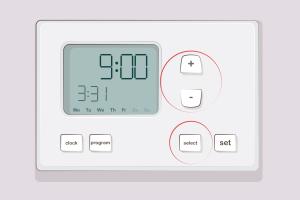Mastering Your Home Comfort: A Comprehensive Guide to Setting a Boiler Timer

-
Quick Links:
- 1. Introduction
- 2. Understanding Boiler Timers
- 3. Types of Boiler Timers
- 4. Step-by-Step Guide to Setting a Boiler Timer
- 5. Common Mistakes to Avoid
- 6. Case Studies: Real-World Examples
- 7. Expert Insights on Boiler Efficiency
- 8. FAQs
1. Introduction
Setting a boiler timer might seem like a mundane task, but it plays a crucial role in maintaining home comfort and optimizing energy efficiency. In this comprehensive guide, we will explore everything you need to know about boiler timers, from understanding their functionality to step-by-step instructions on how to set them up properly.
2. Understanding Boiler Timers
Boiler timers are devices that allow homeowners to schedule their heating systems to turn on or off at specific times. By using a boiler timer, you can ensure that your heating system operates only when necessary, thus saving energy and reducing costs.
Boiler timers can be manual or digital, with digital timers often providing more features such as programmable settings and remote access via smart devices.
3. Types of Boiler Timers
There are several types of boiler timers available in the market today:
- Mechanical Timers: Simple and cost-effective, these timers require manual setting and adjustment.
- Digital Timers: These offer advanced features such as programming multiple schedules and remote control capabilities.
- Smart Thermostats: Integrating with home automation systems, smart thermostats can learn your schedule and adjust heating accordingly.
4. Step-by-Step Guide to Setting a Boiler Timer
Follow these detailed steps to set your boiler timer effectively:
Step 1: Check the User Manual
Before you begin, locate the user manual for your specific boiler model. This document will provide essential information regarding the settings and features of your timer.
Step 2: Locate the Timer Control
Find the timer control unit, which is usually mounted on the wall near the boiler or integrated into the boiler control panel.
Step 3: Set the Current Time
Ensure that the current time is set correctly on the timer. For digital models, this typically involves pressing the 'set' button followed by the hour and minute buttons.
Step 4: Program Your Heating Schedule
Decide on the times you want the heating to turn on and off. For example:
- Morning: 6:00 AM to 8:00 AM
- Evening: 5:00 PM to 10:00 PM
Input these times into the timer, following the instructions in your user manual.
Step 5: Activate the Timer
Once programmed, ensure the timer is activated. Look for an 'On' or 'Auto' setting on the timer control to ensure it will operate according to your schedule.
Step 6: Monitor and Adjust
After a few days, monitor the performance of your boiler timer. Adjust the settings as necessary to improve comfort and efficiency.
5. Common Mistakes to Avoid
Here are some common pitfalls to avoid when setting your boiler timer:
- Not checking the current time before programming.
- Failing to adjust for seasonal changes in temperature.
- Ignoring the user manual for specific instructions.
6. Case Studies: Real-World Examples
Let's explore some real-world examples of how effective boiler timer settings can lead to significant energy savings:
Case Study 1: The Johnson Family
The Johnson family implemented a boiler timer, programming their heating to operate only during waking hours. They reported a 20% reduction in their energy bills over the winter months.
Case Study 2: An Apartment Complex
An apartment complex installed smart thermostats that learned residents' schedules, resulting in a 30% decrease in heating costs across all units.
7. Expert Insights on Boiler Efficiency
Industry experts recommend regularly reviewing and adjusting your boiler timer settings to align with lifestyle changes. This not only improves comfort but also maximizes energy efficiency.
8. FAQs
Q1: How often should I adjust my boiler timer?
A: It’s advisable to adjust your boiler timer every season or whenever you have a significant change in your schedule.
Q2: Can I set my boiler timer remotely?
A: Yes, many modern digital and smart thermostats allow you to set timers remotely via a smartphone app.
Q3: What if my boiler timer is not working?
A: First, check the power supply and ensure the timer is correctly programmed. If problems persist, consult a professional technician.
Q4: Do boiler timers save energy?
A: Yes, by only running your boiler when needed, timers can significantly reduce energy consumption and costs.
Q5: Is a digital timer better than a mechanical timer?
A: Digital timers generally offer more features, flexibility, and precision compared to mechanical timers.
Q6: Can I use a boiler timer with any boiler?
A: Most boilers can work with timers, but it's essential to check compatibility with your specific model.
Q7: How do I know if my boiler is compatible with a smart thermostat?
A: Check the specifications provided by the thermostat manufacturer or consult a heating professional.
Q8: What is the best time to set my boiler to turn on?
A: It’s best to set your boiler to turn on 30-60 minutes before you need heat, allowing it to warm up your space.
Q9: Can I program multiple schedules on my boiler timer?
A: Most digital timers and smart thermostats allow for multiple schedules to accommodate different daily routines.
Q10: What should I do if I forget to set my boiler timer?
A: If you forget, you can manually adjust the boiler settings, or consider upgrading to a smart thermostat that can learn your schedule.